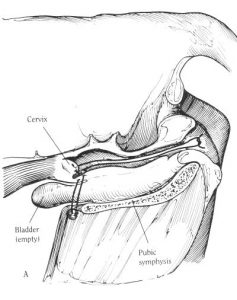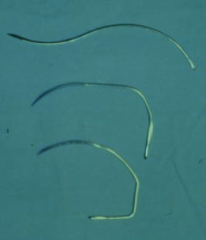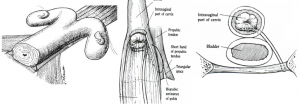Female urogenital surgery
How to – Cervicopexy
Indications
Cervicopexy is indicated for valuable cattle with recurrent vaginal prolapses. It is fairly complex so is generally used for prolapses not responding to other therapies and for donor cows that are repeatedly superovulated but also overconditioned (hard to give epidural, perivaginal fat makes things worse).
Relevant anatomy
The floor of the vagina is sutured to the prepubic tendon, avoiding the artery and the bladder.

Preoperative management
Food restrictions: Animals should be held off feed for at least 24 hours to decrease abdominal fill.
NSAIDs/analgesics: Perioperative NSAIDs are recommended
Antibiotics: Preoperative antibiotics are recommended. Any current inflammation should be allowed to resolve first.
Local blocks: Epidural and local blocks
Position/preparation: The animal is restrained in a standing position. The surgeon working vaginally is gloved. A second surgeon should be ready for abdominal surgery. Place a rigid catheter into the bladder. Create a pneumovagina to tense the vaginal wall.
Surgery Supplies:
- Standard surgery pack
- Bent needle – S needle bent into backwards C with the lower leg shorter than the upper bit

- 3 Vetafil approximately 12 feet long
Surgical procedure
This procedure uses on surgeon in the vagina and one working through the right flank.
The surgeon in the vagina introduces the curved needle through the vaginal floor, just off midline in the fornix. The needle is pushed into the peritoneal cavity.
The surgeon in the peritoneal cavity takes the needle, passes it through the prepubic tendon and pushes it back into the vagina on the opposite of midline.
The first surgeon passes the needle through the ventral aspect of the cervix (not into the lumen) and ties the ends. The cervix is pulled down as tightly as possible.

The surgeon in the flank incision verifies nothing is caught on the abdominal side and then closes the incision.
Colpotomy version
The procedure can be performed by one surgeon if a colpotomy incision is made in the vagina to allow access to the peritoneal cavity. Risk of contamination is greater as is the risk of evisceration if the animal continues straining.
Postoperative care
- Antibiotics and NSAIDs are continued for 3 days.
- Monitor for vaginal discharge
- The suture should be considered permanent.
Complications
Contamination of the procedure may lead to persistent drainage and/or peritonitis and require suture removal.
Transvaginal adhesions -Need loop suture and beach ball
- Loop suture around slightly inflated beach ball
- Cover ball with emmollient
- Pull into vagina from cervix end
- Keeps sides apare for a few days
The procedure can be challenging in obese cattle.

